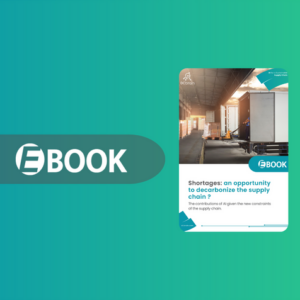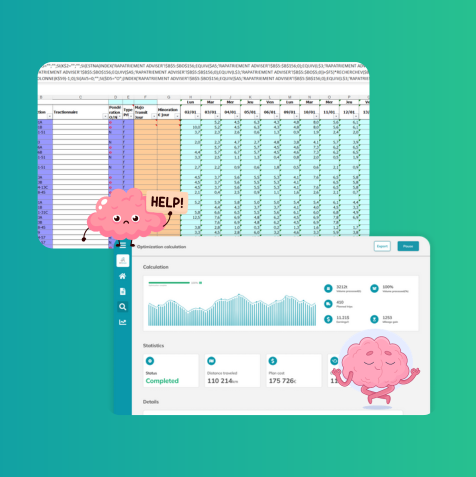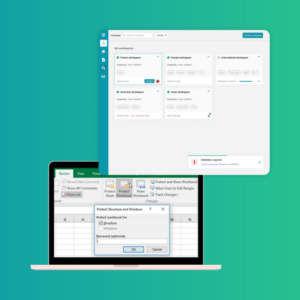
Transportation planning: why Excel might not be the right tool for your organization ?

The majority of companies around the world use Excel. It’s great for processing simple data, calculations, and creating charts. But when it comes to transportation planning, is it really the best solution ?
When we ask Supply Chain departments, 41% of them say they use Excel for transportation planning. However, only 19% express a high level of satisfaction. There might be good reasons for that !
Software latency, overly general features, and a lack of decision support make Excel likely not the most suitable tool for designing transportation plans. Here’s why.
Tasks lacking precision and reliability
First and foremost, Excel is simply a spreadsheet tool. While it’s convenient, it’s not designed to be a specialized solution for specific needs. You won’t find any functionalities related to transportation planning, like simulating multiple scenarios, accounting for industry-specific constraints, integrating key performance indicators (KPIs), mapping visualization, or providing alerts for inconsistencies or anomalies. This is unfortunate, as such features could significantly improve the accuracy and reliability of your calculations.
Secondly, Excel offers a user interface and experience that might not be ideal for your tasks. Have you ever made errors duplicating data to other common tools (TMS, WMS, ERP, for example) due to a lack of centralized information ? Have you ever worried that another user might make a mistake while working with your file, potentially corrupting the data ?
These limitations of Excel hinder the work of planners and complicate the generation of consistent and true-to-reality results.
Neglected challenges of your industry
The criteria to consider in supply chain planning and logistics are numerous and inevitable: product volumes, possible or impossible vehicle groupings, adherence to the cold chain, incompatible schedules between carriers and site opening hours, available resources, and more. These business constraints and operational uncertainties can render meticulously crafted transportation plans obsolete.
Moreover, since industry data is constantly evolving, Excel doesn’t offer automated data updates. Unless you manually update your spreadsheet constantly, it can’t guarantee reliable and coherent transportation plans.
Not being designed as a decision support or optimization tool, Excel may not be the daily tool your profession truly needs for ensuring uninterrupted business operations.
Weak Data Security
Another frustrating constraint, especially for your industry, is Excel’s vulnerability to technical and operational issues. In most cases, your organization heavily relies on the person responsible for creating the file. In the event of their absence or departure from the company, the organization can quickly find itself in a tight spot if no one else has the necessary knowledge to use and update the document. And if someone does manage to do so, how can you prevent errors caused by mishandling, different software versions, or a lack of Excel knowledge ? For smooth and productive collaborative work, this doesn’t seem like the best option…
Moreover, with Excel, the security of your business data is also dependent on hardware. If your organization stores its transportation plans locally in one software, any technical mishap can potentially lead to the loss of the file and its data. The resulting malfunctions and slow recovery can significantly impact the smooth operation of your business. Not to mention the security of sensitive data…
Difficult Management of Data Volume
The last disadvantage of Excel for your profession lies in its very nature. It’s just a spreadsheet tool, poorly suited for managing the volume of data generated – we’re talking about thousands of rows – by your organization. Integrating new information, making updates, and performing critical calculations can be highly time-consuming and sometimes too burdensome for this fragile software. The potential consequences ? Significantly slowed navigation or even a complete halt in operations. These are dangerous roadblocks for your daily organization. The reason is simple: as your data grows and constantly evolves, Excel remains a static program and doesn’t offer the adaptability and scalability your business relies on.
Moreover, Excel doesn’t offer any features designed to provide optimal and consistent readability of this abundance of data. No concrete visualization or mapping that could greatly help with your decision-making.
In the transportation and logistics sector, even a minor hiccup in your organization’s gears can jeopardize business continuity and smooth operation.
To avoid the numerous pitfalls we’ve just discussed, why not abandon Excel for designing your transportation plans and instead turn to a solution that uses artificial intelligence ? A tool that not only takes into account all the specific needs of your industry but also makes planners’ tasks more straightforward and reliable.
Interested? Discover all the possibilities offered by artificial intelligence and DCbrain for your sector.
Other articles

Excel or AI – the battle: which is the better solution for your transport plans ?
Learn more
How to anticipate and optimize your transport needs during the summer period?
Learn more


